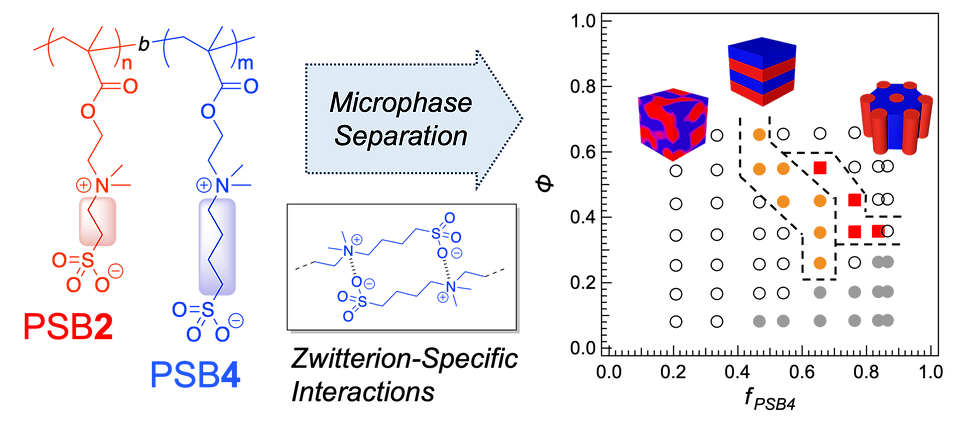Publication Report, 15 July 2025
- Yuji Higaki

- 7月19日
- 読了時間: 2分
Yuji Higaki,* Yasuhiro Eguchi, Takumi Masuda, Yuri Mitsunobu
"Lyotropic Microphase Separation in Aqueous Solutions of Double Sulfobetaine Diblock Copolymers Induced by Charge Separation Length Mismatch"
Macromolecules, in press. DOI: 10.1021/acs.macromol.5c01463
Does the variation in charge separation length of zwitterions induce phase separation and ordered structural assembly of zwitterionic polymers in water?
Microcompartments produced via liquid-liquid phase separation of polymer solutions are promising as transient microenvironments that can be generated on demand with minimal energy consumption. Lyotropic microphase separation in aqueous solutions of a double hydrophilic diblock copolymer composed of two distinct polysulfobetaine chains, poly(2-(N-2-methacryloyloxyethyl-N,N-dimethyl)ammonioethanesulfonate (PSB2) and poly(4-(N-2-methacryloyloxyethyl-N,N-dimethyl)ammoniobutanesulfonate (PSB4), with very similar chemical structures but different charge separation length (CSL) within the sulfobetaine moieties (PSB2-b-PSB4) was investigated. The aqueous solutions of PSB2-b-PSB4 undergo phase separation due to specific interactions between identical sulfobetaines, triggered by differences in their CSL. The structural similarity of the zwitterions induces increased miscibility, lattice distortion, and morphological change. These results can be rationalized in terms of the low Flory-Huggins interaction parameter (χ) for PSB2/PSB4, the poor hydrophilicity of PSB2, and weak interactions between PSB2 and PSB4. These unique mesoscale aqueous molecular assemblies, produced by microphase separation of double-hydrophilic block copolymers with high chemical symmetry, are promising as novel aqueous compartments for molecular reservoirs.
Yasuhiro "BOB" Eguchi was in charge of this project. He is a sincere and earnest individual whose good sense of humor and cheerful personality bring a sense of warmth to those around him. He is always willing to support junior colleagues and is truly a great guy. I was particularly struck by how genuinely happy he was when his juniors received an award. He approached the research with meticulous planning and steady, dedicated effort, ultimately producing an excellent piece of work. I sincerely wish him continued success and happiness in his future career in the private sector.
This work was supported by JSPS KAKENHI Grant Nos. JP22H02147 (Grant-in-Aid for Scientific Research (B)), JP22H04555, and JP19H05714 (Grant-in-Aid for Scientific Research on Innovative Area: Aquatic Functional Materials). Y.H. acknowledges the Toshiaki Ogasawara Memorial Foundation for financial support. This work was also supported by the Oita University President’s Strategic Discretionary Fund and the Cooperative Research Program of the Network Joint Research Center for Materials and Devices.





コメント